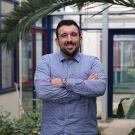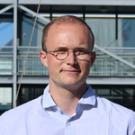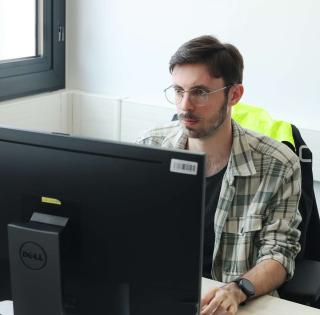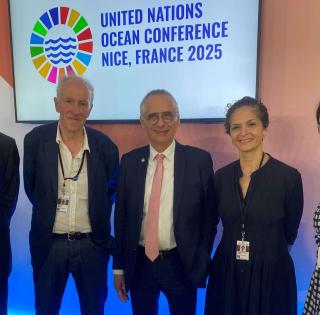
The research hub wishes to actively contribute to the development of efficient, autonomous, reconfigurable and intelligent communication systems.
ENSTA Bretagne researchers primarily contribute to the “Security, Intelligence and Integrity of Information” (SI3) team.
“Security, intelligence and integrity of information” research areas
The team designs and develops methods, algorithms and solutions for securing the physical layer of future communications and transmission systems.
Its contributions also involve testing the deployed standards and systems or carrying out the corresponding “reverse engineering” for our institutional defense or national regulatory partners.
In this area, everything can be considered as a challenge, because most of the reception processing is generally performed blindly and/or with very severe operational constraints in terms of stealth, threshold of noise level, own or external interference, power consumption, spectral efficiency, security, etc.
These research topics are at the intersection of signal processing, mathematics, “classical” and quantum information theory, and require consideration of major criteria and constraints related to operational, confidential, secure and other hardware aspects of the considered applications.
APPLICATIONS
- Tactical communications in defense and aerospace, radio spectrum monitoring, Cognitive Radio, securing restricted access areas and critical systems,
- Drones, the Internet of Things (IoT), Smart factory, autonomous cars and radars embedded in vehicles.
- Applications of advanced signal processing methods, wireless telecommunications techniques and artificial intelligence in the biomedical field.
COLLABORATIONS
- Institutions: DGA, ANFR, Brest Teaching Hospital (CHU), Brest Military Hospital, etc.
- Academia: Naval Academy, GIPSA, UBO, Université de Paul Sabatier Toulouse 3, AUCE (Beirut-Lebanon), SNCS (Tabuk – KSA), ISEN, AAMST (Cairo - Egypt), etc.
Expertise
- communications systems,
- information processing and protection,
- information encoding and decoding,
- algorithm-architecture matching,
- physical layer security,
- artificial intelligence.
This study is aimed at modeling, simulating and optimizing aerial drones’ physical communication channels (from the transmitter to the receiver), with account taken of operational contexts.
It is the second stage in a vast research program commissioned by the DGA, the aim being to optimize the quality of communications between an aerial drone and its operator based on land, or between several drones and their operator. Tools for calculating missions and controlling the drones will have to take the operational contexts into account for that, not least such natural features as terrain or dense vegetation, which limit wave propagation.
This path loss coefficient was modeled during the first study. The new study has several additional objectives.
First of all, finding the best routes for maintaining the highest possible path coefficient. The researchers are developing effective optimization techniques in that respect, which incorporate radar wave propagation models (mathematical theories of optimization).
Other parameters taken into account include flight management and drone orientation. These also affect radio frequency communications and are factored into models using AI algorithms (reinforcement learning).
Finally, mission calculation methods may bring two or more drones into play to ensure this optimization of communications. In that case, the researchers study the extent to which the algorithms developed are capable of coping with the combinatorial explosion inherent in the multi-drone context.
- thesis subject: “Towards Effective Strategies for Data Collection and Decision-Making for Sensor Networks with Limited Resources”
- defended in December 2021
- keywords: Sensor Networks, Energy Efficiency, Decision-making, Data Reduction, Spatio-Temporal Correlation, Planning Strategies.
The high potential of sensors is hampered by two major technological hurdles: the limited resources of their batteries and the difficulty collecting large datasets in real-time. This theme aims at outlining various mechanisms for collecting and analyzing data to overcome these challenges, on the basis of sensor network architecture (clustering).
The results obtained during testing have demonstrated the effectiveness of these mechanisms in terms of energy consumption, data precision and scope, and improve the performances of sensor networks.
The mechanisms proposed operate at three network levels. They aim at reducing the quantity of data disseminated through the network while protecting the integrity of information.
- At sensor level, we outline methods for the prediction, aggregation and compression of data based respectively on the algorithms of Newton Forward Difference, divide-and-conquer and similar data elimination, with a view to reducing the raw data collected by each sensor.
- At “Cluster Head” level (i.e. leading node in the sensor network), we outline new techniques for clustering, fusion, intermediate aggregation and scheduling aimed at looking for correlations between the neighboring nodes and eliminating existing redundant data before sending the data to the sink.
- At sink level (node/gateway of the sensor network), we introduce effective decision-making models based on a score table, allowing end users to analyze the data and make a fitting decision.
These programs are conducted with the military hospital and teaching hospital (CHRU) in Brest.
- Acquisition and processing of electrocardiograms of a fetus and its mother using wireless sensors.
- Characterization and classification of deep vein thrombosis (blood clot).
- Use of EEG (electroencephalogram) and EMG (electromyogram) signals to control a wheelchair for a paraplegic.
- Use of EOG (electro-oculogram) signals to activate and browse a web page by a paralyzed person: produce a wireless ECG sensor and simulator for the Faculty of Medicine.
By estimating the characteristics of the transmission channel to improve information transmission and protection.
- Game theory to develop protocols for a tactical cognitive radio.
- Smart Antenna & Beamforming: the antenna has to adapt to its environment automatically.
- Internet of Things and wireless network problems associated with the coexistence of machine-to-machine (M2M) and human-to-human (H2H) communications.





















